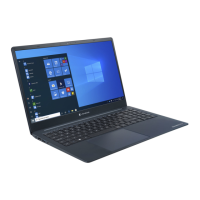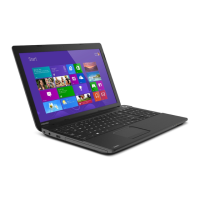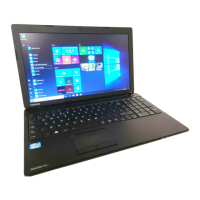
Do you have a question about the Toshiba Satellite C50-B Series and is the answer not in the manual?
| Weight | 2.2 kg (4.85 lbs) |
|---|---|
| Optical Drive | DVD Super Multi Drive |
| Connectivity | Wi-Fi 802.11 b/g/n, Bluetooth 4.0 |
| Card Reader | SD Card Reader |
| Webcam | HD Webcam |
| Processor | Intel Celeron / Pentium / Core i3 |
| RAM | Up to 8GB DDR3L |
| Storage | 500GB HDD |
| Display | 15.6-inch, 1366 x 768 pixels |
| Graphics | Intel HD Graphics |
| Operating System | Windows 8.1 |
| Battery | 4-cell Lithium-ion |
| Ports | 1 x USB 3.0, 2 x USB 2.0, HDMI, Ethernet |
Covers copyright notices, disclaimers, and trademark information for the manual.
Details legal and regulatory compliance, including FCC and EU declarations.
Explains licensing terms for the OpenSSL Toolkit software.
Outlines the licensing terms for the FreeType font engine.
Information on the computer's compliance with ENERGY STAR guidelines for energy efficiency.
Covers disposal of computer/batteries, optical drive safety, general precautions, and safety icons.
Lists included hardware/documentation and explains manual formatting conventions.
Guides on first-time use, connecting power, powering on, and initial OS setup.
Covers Taskbar, Power options, Charms, Tiles, and Sign-in methods for Windows.
Explains how to Shut Down, Restart, use Sleep, and Hibernation modes for power saving.
Details components on the front, left, right, back, and underside of the computer.
Describes internal components like Battery, CPU, HDD/SSD, Memory, and GPU.
Explains power status indicators (DC IN/Battery, Power) and battery charging conditions.
Covers Touch Screen and Touch Pad gestures, operations, and functionality.
Details keyboard layout, function keys, special Windows keys, and indicators.
Explains supported disc formats, disc insertion/removal, and writable disc types.
Notes on CyberLink PowerDVD, external display connections, and audio settings.
Covers battery care, charging, monitoring, extending life, and LAN connection procedures.
Introduces utilities like Desktop Assist, Display Utility, Password Utility, and System Settings.
Covers TOSHIBA eco Utility, Media Player, CyberLink MediaStory, and Resolution+ features.
Details PC Health Monitor, Audio Enhancement, and TOSHIBA Gesture Controller functionality.
Explains advanced features like power management modes and system recovery procedures.
Systematic approach to identifying and solving computer problems, including checklists and analysis.
Solutions for issues with power, input devices, display, drives, and connectivity problems.
Addresses problems with BIOS, keyboard, sound, LAN, wireless, and Bluetooth connectivity.
Guidance on seeking technical help from TOSHIBA support resources and warranty information.
Physical dimensions, environmental requirements, and power specifications for the computer.
Port assignments, power cords, certifications, and wireless technology interoperability.
Explains wireless regulations, radio frequency interference, and Bluetooth compliance across regions.
Explanations of performance variations, technical terms, and acronyms used in the manual.








